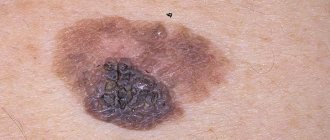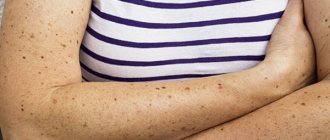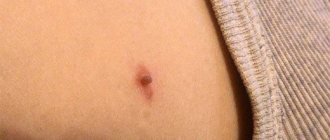A white dot on a mole is a cause for concern for the owner of an unusual growth. A person cannot understand the reason for its appearance, its nature and predict whether it poses a health risk. Such growth, which does not cause discomfort, simply needs to be controlled; if there are doubts about its benignity, consulting a dermatologist or oncologist will not hurt.
Causes of white dots
The appearance of moles on the body is a common process that accompanies human life. Some treat such formations calmly, others consider them potentially hazardous to health, remembering that the risk of degeneration into melanoma is always present.
Nevus by its nature is a pathology that is congenital or acquired during life.
A pigment spot appears on any part of the body: face, stomach, back, limbs. In most cases, it does not pose a danger and is benign in nature. Malignancy mostly concerns atypical elements, including the appearance of white spots on the growth.
In some cases, a person feels the formation of a rod inside the nevus. It may be a manifestation of acne when a mole appears in places with a large number of sebaceous glands on:
- back;
- breasts;
- face.
A white spot appears due to a reduced number of melanocytes in the pigmented area. He talks about malfunctions in the body and requires consultation with a doctor.
Safe
White inclusions appear for a number of physiological reasons that do not pose a threat to human health.
- Genetic factor. Visible lightening of the nevus may be a congenital feature of a person that manifests itself throughout life. A similar situation is often observed in vitiligo disease.
- Lightening of a birthmark may be the body’s reaction to excess ultraviolet radiation, which provokes increased melanin synthesis.
- Violation of the natural pigmentation of the skin is caused by aggressive exposure to radio waves.
- Hormonal imbalances often cause the appearance of white spots. It is mainly observed during the periods of pregnancy, lactation, puberty and the onset of menopause. Treatment with hormonal drugs for endocrine and gynecological pathologies is another reason for this situation.
- An insect bite in individual cases provokes such a reaction.
- Acne, acne. People prone to similar skin problems notice that blisters appear on the growths, containing pus inside. There may be acne. Squeezing blisters is prohibited. The necessary treatment is prescribed by a dermatologist.
White dots on a nevus, which are observed in a person throughout his life and do not change in size or shape, do not pose a health hazard.
Requiring medical attention
In individual cases, white spots that appear on a mole require medical supervision. Will help prevent the development of dangerous pathological processes.
- Lightening of pigment for no apparent reason.
- The appearance of white spots after injury to a nevus, an insect bite, or squeezing out a pimple that has formed on it.
- The appearance on the surface of a bubble filled with liquid inside, accompanied by itching.
- Lightening a mole after prolonged exposure to ultraviolet radiation or tanning in a solarium.
You should not ignore the situation that has arisen.
A timely examination by a qualified specialist and tests will help identify the type of formation. The doctor will prescribe the necessary treatment.
Types of moles
The most harmless moles are pigmented ones, they are called lentigo.
They look almost like freckles and are very easy to confuse. Such moles are formed due to the accumulation of melanocytes under the skin, cells responsible for pigmentation. All other types of birthmarks can cause trouble for their owner. These are epidermal-dermal nevi - moles that can rise above the surface of the skin, usually located on the palms, feet or in the groin area. Intradermal nevi are convex, often covered with hair. Dysplastic nevi are irregularly shaped tubercles with unclear boundaries; they can be more than a centimeter in size.
One of the most dangerous is a giant nevus. This is a congenital spot that can cover large areas of the skin. It is usually removed early, since it looks scary, and the risk that it will degenerate into a malignant formation is quite high.
Treatment methods for a white spot on a mole
Medical assistance to a person who has discovered a clearing of a nevus without accompanying pathological causes is not needed. It is enough to observe a suspicious element and undergo examinations by a dermatologist for preventive purposes.
If pathological processes are present, treatment is prescribed immediately.
- If there is a threat of degeneration into a malignant tumor, the oncologist carries out the necessary diagnostics to determine the type of formation, prescribes complex therapy and recommends removing the mole.
- Surgical treatment of oncology is carried out. Otherwise, the risk of relapse and the development of numerous complications increases.
Nevus is removed:
- surgical excision;
- cryodestruction;
- electrocoagulation;
- radio wave method;
- laser device.
Preference is given to a method after which it is possible to conduct histology.
So the doctor will once again check the nature of the formation. Depending on the chosen method, further treatment is prescribed and recommendations for wound care are given.
Special attention area
The transformation of a benign tumor into a malignant one can occur slowly, over several months or years, or it can happen suddenly, in a very short time. But if trouble strikes, dangerous cells will begin to divide rapidly, so it is important not to miss the moment and undergo regular preventive medical examinations. Please note: in these cases, you need to run to the dermatologist as fast as you can.
- Pigment formations of asymmetrical, irregular shape and outline, similar to a geographical map.
- Multi-colored moles with shades of brown, red, gray and blue.
- The nodules are regular in shape, but unevenly colored.
- Sharply growing moles.
- Causes concern - itches, hurts or bleeds.
- Eight spots larger than 6 mm.
- Multiple scatterings (from 50 pieces) larger than 2 mm.
Is it possible to squeeze out a mole with a white spot in the center?
The formation of a white core in a mole is not always alarming. Many people make the mistake of trying to squeeze it out. With superficial damage, internal tissues can be injured. If the process spreads to the subcutaneous fat layer, an abscess may develop. The active growth of the purulent focus begins. Necrosis often forms in its center.
Complications will negatively affect the growth. The inflammatory process will begin.
There is pain and swelling of the nevus itself and the skin around the affected area. Such changes several times increase the risk of malignancy of an initially benign growth.
When squeezing out the formation, a person can introduce an infection inside. Inflammation that develops after the incident is another risk factor for malignancy. It cannot be ruled out that after squeezing the pimple will not appear again. The area of the rash may increase significantly.
What symptoms should you see a doctor for?
The reason to check the condition of a mole with a white dot in the center should be:
- change in size: sudden growth or reduction;
- the appearance of purulent, bloody, bloody discharge from the head;
- increased body temperature;
- the appearance of itching;
- pain in and around the nevus;
- skin redness;
- the appearance of microcracks on the surface.
An obligatory reason for examination by a doctor is an injury to the formation.
The affected area must first be treated at home to stop the bleeding, if necessary, apply a bandage and cover with a bandage. Such measures will prevent infection. After the examination, the specialist will prescribe the necessary treatment: treatment with antiseptics and ointments. Deep injury requires a more detailed examination, dermatoscopy. If necessary, the nevus will be removed.
Self-medication is prohibited. It can lead to suppuration of the wound and the development of an inflammatory process.
Possible complications
Formations of a benign nature, even with white inclusions present, may not cause inconvenience to a person throughout his life. The danger lies in the malignancy of the mole, but the degeneration is preceded by a number of factors that are impossible not to notice.
To prevent malignancy, several recommendations should be followed:
- tanning should be moderate. Prolonged exposure to ultraviolet radiation (UV rays), frequent visits to the solarium are one of the causes of degeneration;
- It is forbidden to squeeze out white formations on nevi, comb them, or tear them off;
- It is necessary to eliminate bad habits, reduce the amount of coffee consumed, and avoid stress.
Numerous moles on the body require careful attention. The appearance of unpleasant, disturbing symptoms is not always a sign of the development of melanoma, but, most likely, an indication of malfunctions in the body. Understanding the mechanisms of malignancy of nevi, preventive examinations, and a healthy lifestyle will protect you from troubles with moles, even if they have white dots.
Which moles are not dangerous, but require mandatory consultation with a doctor?
A blue nevus
is a spot, nodule or node of dark blue, black or gray color up to 1 cm in size. The color is due to the large number of cells with melanin in the dermis. Such moles have a dense consistency and are most often located in the scalp area, on the dorsum of the hands and feet. Blue nevi usually appear in early childhood, more often in girls, and grow slowly.
Spitz nevus
- This is a reddish-pink or yellowish nodule, most often located on the face and limbs in pre-teen children, and quickly increases in size. It may be a sign of poor nutrition and gastrointestinal problems. Removal is usually required.
Galonevus
makes itself felt in people with reduced immunity and severe autoimmune diseases. A white rim appears at the site of the mole. Occurs more often in childhood and adolescence.
Spotted nevus
is a light brown café au lait spot ranging in size from 1 to 15 cm or more. Against its background there are small dark brown spots or nodules of 2-3 mm. Lesions usually develop before the onset of puberty. The reason is a failure in the structure of pigment cells containing melanin.
Mongolian spot
- a pigment disorder of a grayish-blue color, usually located in the lumbar region, sacrum, buttocks, less often - on the head under the hair. In Mongolian newborns it occurs in 90% of cases, in representatives of other nationalities - no more than 0.5%. As a rule, it disappears in early childhood.
Nevus Ota
- a gray or blue spot around the eye caused by genetic neurological factors. May be subtle or bright. Mainly found among Asian peoples.
Flaming (wine) nevus
looks like an irregularly shaped red or purple spot. Arises from birth, formed from dilated capillaries. As the child grows, it enlarges and becomes lumpy and never resolves on its own. The exception is nevus of Unna. A red spot (sometimes called a “stork bite” or “angel’s kiss”) is located on the back of the neck, sometimes on the eyelids and bridge of the nose. Approximately a third of newborns have it and disappear by 3-5 years.
Anemic nevus
- white spots with irregular edges on the chest or back. The reasons are a violation of the development of blood vessels in a certain area of the skin. It is practically not noticeable in infants, but is more pronounced at school age.
The interpretation of moles - moleosophy - was one of the ways to predict fate in ancient times. So, for example, owners of moles on their faces were considered exalted persons. A mole on the right side of the chest for representatives of the stronger half is a sign of an easy character, on the left - a sign of love; on the woman’s right breast - a sign of material well-being, on the left - to her first-born boy.
The main danger of moles is that some types can degenerate into melanoma, a malignant neoplasm with an aggressive course. It occurs in both young people and children, and the frequency of detection is increasing year by year. Over more than half a century, the prevalence of the pathology has quadrupled. Among all malignant tumors, melanoma accounts for less than 10%, but causes 80% of deaths from cancer.











